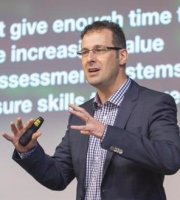One Reason Flipped Learning Makes Sense in a STEM Classroom
This is the first generation of STEM teachers who must choose between teaching important skills and teaching urgent skills. In previous generations, there was no difference. The important skills were the urgent skills. Now there is a fork in the road, which presents a threshold challenge to STEM teachers in 2017.
“Importance” is about how much something matters. “Urgency” is about how soon it matters. In previous generations, it was understood that the more knowledge students had when leaving school, the better their career prospects. The urgency of exam preparation incentivised students to learn the important skills that would later underpin their career success. But that is no longer true.
There is a growing, collective understanding among STEM teachers that the skills which prepared yesterday’s students to thrive in a knowledge economy are inadequate preparation for today’s students. As information continues to be commoditised and processes automated, retaining knowledge is less important than it once was. It is still helpful for a student to know the first 20 elements of the periodic table, but failing to know them is a much smaller handicap than it was 20 years ago. After all, you can ask Siri what the atomic mass of copper is, should you ever need that information.
I’m not saying (as some do) that knowledge has no value, nor that looking something up (no matter how efficiently) is as good as remembering it. If students are ignorant on a topic, they have no filter through which to sift new information. In a “post-truth” world, critical thinking is more valuable than ever and critical thinking is problematic for someone who lacks the context that knowledge affords. Nevertheless, YouTube is a pretty effective knowledge prosthesis.
Creativity, problem-solving, resourcefulness, computational thinking … these are skills that have always been valuable but are now at a premium! Teachers get this. Every time I mention it in a presentation I notice teachers nodding. But there seems to be a disconnect between that understanding and the way many teachers plan their classes. Many of us still spend a large portion of our class time teaching knowledge. Why? Because in November students will sit an exam to answer questions that in any other context would be googleable! If we have failed to prepare them for that we will have let them down. We’ll not have done any favours for our own reputation, either! Personally, I don’t think exams effectively measure student learning in any meaningful way in 2017. But as a science teacher I have no influence over the State’s assessment processes (“God grant me the serenity…”). For as long as exams are the gate through which students must enter to pursue a STEM career, we need to hold that gate open for them.
Therein lies the dilemma we face in 2017. Do we spend our valuable class time on the most important or the most urgent things? Do we equip our students with the skills that will matter to them most, or those that will matter to them first? Do we prepare them to thrive in the economy of the future, or to thrive in the exams of November?
I don’t think we can neglect either! But clearly there is insufficient time to do both.
Since we are unlikely to be given more time, we need to make more efficient use of the time we have.
A common criticism of the flipped classroom model is that it is still a fundamentally didactic, teacher-centred approach. I don’t disagree with that – although if done well, I do think that it is much more student-centred than it might seem. Nevertheless, it is not my aim in this article to discuss different approaches to the flipped classroom model, how to do it well, nor to explain how it can be student-focussed. The point I want to make in this article, rather, is that it is much more efficient than traditional approaches. By taking didactic learning out of the classroom, class time is reclaimed for more “important” learning tasks, those which prepare students for the economy of their future. At the same time, it allows students to cover the “urgent” content they need for exams much more efficiently. They can, for example, listen to a lesson at double speed, while multi-tasking it with washing the dishes (or some other mindless chore), thereby saving precious at-desk study hours for other tasks. It also makes that kind of learning demonstrably more effective.
In many ways, I think the term “flipped learning” does a disservice to the concept of flipped learning by implying that it is the wrong-way-round. On the contrary, I think it should be the new normal – at least until we do away with high-stakes standardised testing.
Nobody races down to the bank during lunchtime any more, to withdraw cash during bank hours. Instead, we enjoy lunch with our colleagues in the staffroom. Then we multi-task cash-withdrawal with our grocery shopping that evening when the bank is closed. We don’t call it “flipped banking” – but that is what we are doing! We are using technology to time-shift a necessary, “urgent” errand to make more efficient use of our time, while also reclaiming our lunch time to rest and cultivate rapport with colleagues – both of which, are important but not urgent.



You must be logged in to post a comment.